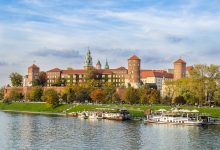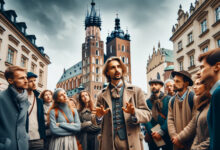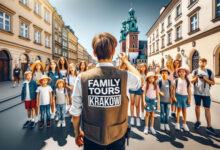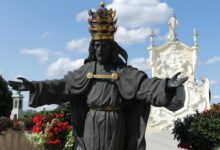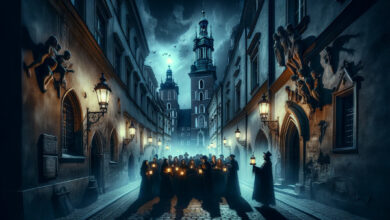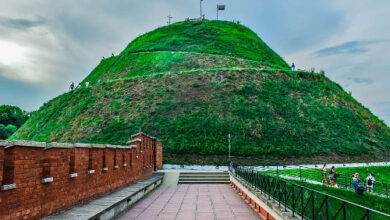Wawel Castle and Wawel Hill hold a special place in the history and culture of Poland, establishing themselves as some of the most significant sites in the country. At the top of Wawel Hill, the Wawel Castle has long symbolised Polish statehood, having served as the residence of kings for centuries.
Today, Wawel Castle has transformed into a premier art museum, offering visitors a chance to immerse themselves in the rich past of the nation and marvel at its artistic treasures.
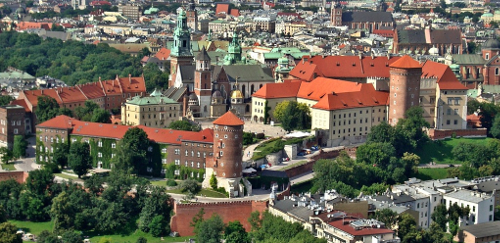
The castle complex, situated 230 metres above sea level, majestically dominates the skyline of Kraków, casting its presence over both the Old Town and Kazimierz districts.
Wawel Hill can trace its origins back to the 8th century, with fortifications and legends hailing from a time when Kraków was steadily growing in importance. This remarkable history has left its mark on the castle and the surrounding area, making it a must-visit destination for those seeking a glimpse into Poland’s past.
At Wawel Castle, visitors can explore the ten curatorial departments responsible for a variety of art collections, including paintings and other objects of historical significance.
While roaming the castle grounds, one cannot help but appreciate the intertwining of history, culture, and art that defines this exceptional site.
Table of Contents:
Wawel Castle and Wawel Hill
Location and Significance
Wawel Castle is situated on Wawel Hill, overlooking the city of Kraków and the Vistula River. At a height of 230 metres above sea level, the castle and the hill it stands on are both historically and culturally significant sites in Poland. Located between the Old Town and Kazimierz districts,
Wawel Hill and Castle have been symbolic of Polish national identity and statehood for centuries, serving as the residence of the kings of Poland.
Historical Background
Wawel Hill, with its fortifications dating back to the 8th century, has been steeped in legends and tales as Kraków gradually grew in importance. In 1930, Wawel Castle was transformed into an art museum showcasing an impressive collection of artworks and artifacts.
The museum comprises ten curatorial departments responsible for collections of paintings, sculptures, and other historically significant items.
As a premier symbol of the nation, Wawel Castle and Wawel Hill serve as reminders of Poland’s rich history and the architectural achievements of its people.
The significance extends not only to the Polish people but also to the countless visitors drawn to explore the castle, its museums, and its beautiful surroundings near the Vistula River.
Architecture and Art
Renaissance Palace
The Wawel Castle features a Renaissance Palace, which is a fine example of Italian-influenced Renaissance architecture in Poland.
Completed around 1578, this palace was constructed under the patronage of King Zygmunt I and King Zygmunt II August.
The Italian architects who contributed to its design included Bartolomeo Berrecci and Francesco Fiorentino.
The palace features stately rooms and courtyards, with ornate interiors that showcase a blend of Renaissance and Baroque styles.
Gothic Castle
The Gothic Castle at Wawel Hill is another remarkable aspect of the complex. Dating back to the 14th century, it serves as one of the earliest examples of Gothic architecture in Poland.
The castle was expanded over the centuries, with various rulers adding fortifications and structures to the complex.
Notable elements of the Gothic Castle include the impressive outer walls, and a bastion that was added in the 17th century by the castle’s owner, Michał Zebrzydowski.
Wawel Cathedral
Wawel Cathedral, also known as the Royal Archcathedral Basilica of Saints Stanislaus and Wenceslaus, is a stunning representation of various architectural styles throughout the centuries.
The cathedral includes Gothic, Baroque, and Neoclassical elements that have been seamlessly integrated during its numerous reconstructions and expansions.
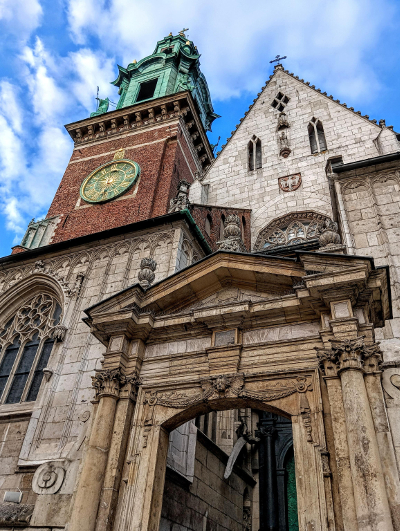
The Gothic nave of the cathedral dates back to the 14th century, featuring high ceilings and intricate stone carvings.
The Baroque elements are evident in the chapels added during the 17th and 18th centuries, displaying ornate decorations and ornamental altarpieces.
The Neoclassical façade was added in the 18th century, further complementing the mix of styles found within the Wawel Cathedral.
Within the cathedral, a vast collection of art and historical artefacts are displayed, including paintings, sculptures, and relics associated with Polish history and royalty.
This combination of architectural styles and art collections makes Wawel Castle and Wawel Hill one of the most culturally significant sites in Poland.
Major Components of Wawel Castle
State Rooms
The State Rooms in Wawel Castle served as the primary public chambers for the Polish royalty. These magnificent rooms housed various events, receptions, and ceremonies.
The grand interiors of these rooms possess period furniture, elaborate friezes, and striking works of art.
The castle’s collection of art and sculptures allows visitors a glimpse into the lavish lifestyle and the rich history of the Polish rulers.
Royal Private Apartments
The Royal Private Apartments were the living quarters of the kings and queens, where they could retreat and enjoy their privacy.
These apartments featured a blend of ornate decoration and practical function.
The rooms included intricately made furniture, fine textiles, and impressive artwork, which showcased the royal taste and wealth.
Crown Treasury and Armoury
The Crown Treasury and Armoury housed a vast collection of valuable items, from the finest weaponry to precious jewels.
The Armoury displayed an impressive array of weapons, armour, and military equipment used in battles and ceremonies.
The Crown Treasury held treasured objects such as the coronation sword, national artefacts like the royal seal and sceptre, and beautiful Ottoman tents.
Conservation and Restoration
The Wawel Castle underwent periods of decline and damage throughout its history due to wars and political upheavals.
Conservation and restoration efforts have been essential in preserving the cultural and historical significance of the castle.
Today, the castle operates as a premier art museum, with ten curatorial departments dedicating themselves to maintaining the collections and the structure.
With continuous attention to restoration and preservation, the castle’s rich heritage endures for the enjoyment and education of visitors from all over the world.
Museums and Exhibitions
Art Museum
The Wawel Royal Castle is home to a significant art museum, which houses an impressive collection of Italian Renaissance paintings.
These masterpieces were acquired through various acquisitions, and their display offers visitors a glimpse into the rich artistic history of the castle.
The art museum also includes pieces from other eras, ensuring a diverse and engaging experience for art enthusiasts.
Sigismund II Augustus Tapestry Collection
A key attraction within the Wawel Royal Castle is the Sigismund II Augustus Tapestry Collection.
This collection of tapestries is considered one of the most valuable and largest sets of its kind in the world.
The tapestries were commissioned by King Sigismund II Augustus, who spared no expense in obtaining the finest materials and craftsmen to create these stunning works of art.
These tapestries feature intricate designs and detail work, showcasing the incredible talent of the artists and weavers who crafted them.
Visitors to the Wawel Royal Castle can admire these exquisite tapestries on display, providing an insight into the opulent tastes of the Polish royalty during the Renaissance period.
Legends and Mysteries
Wawel Dragon
Wawel Hill, along the banks of the Vistula River in Poland, is home to the ancient and mysterious tale of Smok – the Wawel Dragon.
According to legend, Smok was a fearsome fire-breathing creature that lived in a cave beneath the hill, terrorising the area and the nearby settlements. The mythical beast had an insatiable appetite, devouring humans and livestock alike.
The legend goes on to say that the dragon was eventually slain by a brave and clever prince named Krakus, who would later become King Krakus and be remembered as the founder of the city of Krakow.
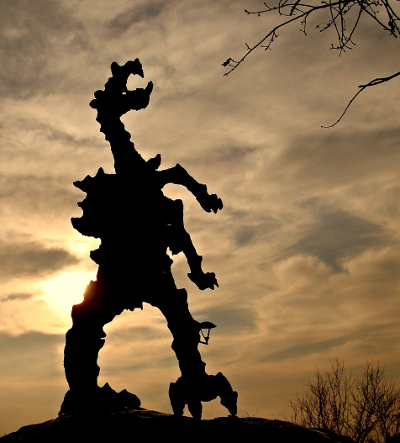
Today, the memory of this legendary creature is preserved through a metal statue of a fire-breathing dragon at the foot of Wawel Hill.
King Krakus
King Krakus, the legendary founder of the ancient Polish capital city of Krakow, is known for his heroic defeat of the Wawel Dragon.
His victory over the fierce beast allowed the land to prosper and eventually led to the establishment of the city in the 7th century. The story of King Krakus and the Wawel Dragon is a central part of Polish folklore and is considered the origin of the city’s name.
King Krakus not only defeated the Wawel Dragon, but also became a beloved and wise ruler of his people.
According to folklore, his reign ushered in an era of peace and prosperity for Krakow. It is said that Krakus’ remains were laid to rest atop Wawel Hill, now the site of the historically significant Wawel Royal Castle.
In summary, the legends and mysteries surrounding Wawel Hill are an important part of Poland’s cultural heritage.
These tales evoke a rich history filled with heroism, struggle, and victory, embodied in the figures of the fearsome Wawel Dragon and the steadfast King Krakus. These stories serve to connect modern Krakow with its ancient past, preserving the city’s spirit and identity for generations to come.
Visiting Wawel Castle
Tourist Information
Wawel Royal Castle is a must-see attraction in Krakow, Poland. This historic site offers visitors an opportunity to explore beautiful churches, palaces, and gardens overlooking the Vistula river.
Tickets for admission can be purchased online or on location.
To reach the castle, one can take a leisurely 10-minute walk from Krakow city centre, or use the tram network with multiple trams stopping near Św. Gertrudy 25, just 3 minutes away from the castle.
Guided Tours
A knowledgeable guide will take visitors around the castle grounds, explaining significant historical events and sharing captivating stories about the Polish monarchs who once resided there.
Many guided tours are available in English, making it easier for international tourists to fully enjoy the Wawel experience.
Another recommended guided tours:
Nearby Attractions
While visiting Wawel Castle, make sure to explore some of the nearby attractions on and around Wawel Hill:
- Wawel Cathedral: A key religious and historical site for Poland, with a stunning Gothic architectural style.
- Smocza Jama (Dragon’s Den): A renowned cave with connections to the legendary Smok Wawelski, the Wawel Dragon. Ulica Smocza, or Dragon Street, leads to a cast metal sculpture of the Wawel Dragon that playfully breathes fire.
- Pieskowa Skała Castle: A branch of the Wawel Royal Castle, this picturesque fortress is worth a visit to further explore the region’s history.
- Manor House at Stryszów: Another extension of the Wawel Royal Castle, this historic manor is nestled within picturesque surroundings.
To complete the Wawel experience, visitors can also indulge in local and international cuisine at nearby restaurants, offering a diverse range of dining options to accommodate different preferences and budgets.
Historical Figures and Royal Legacy
Polish Kings and National Heroes
Wawel Castle was the residence of many significant figures in Polish history. One of the most famous kings to reside there was King Władysław II Jagiełło.
He ruled from 1386 to 1434 and forged a close alliance with Lithuania. This led to the creation of the Polish–Lithuanian Commonwealth, a powerful union in European history.
Another prominent ruler was King Casimir III, also known as Kazimierz, who reigned from 1333 to 1370.
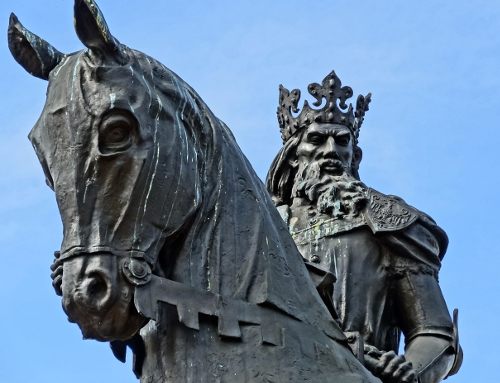
Under his rule, Poland experienced a golden age of prosperity, and he significantly expanded and developed the territory.
King Casimir III was also responsible for the construction of many of Wawel Castle’s structures, making crucial contributions to its architectural development.
Sigismund I was another essential figure connected to Wawel Castle. He ruled from 1506 to 1548 and invested heavily in the arts and culture of Poland. His reign saw the flourishing of the Polish Renaissance and numerous architectural developments in the castle.
Apart from the kings, national heroes like poets and leaders who significantly contributed to Polish history also have a connection to Wawel Castle and its legacy.
These individuals are celebrated for their meaningful impact on the nation and the continuity of its cultural heritage.
Royal Clerks and Craftsmen
Wawel Castle wasn’t just home to the ruling elite, but also to several esteemed royal clerks and craftsmen from various parts of Europe.
These individuals were integral to the development and success of the Polish court, as well as the administrative and cultural aspects of the kingdom.
Many craftsmen who worked on Wawel Castle’s architectural projects originated from Flanders. They were known for their expertise and workmanship, which helped create some of the most iconic facets of the Castle’s design.
Royal clerks were responsible for managing the daily affairs of the court, keeping records, and organising events. They played a vital role in maintaining the order and functionality of the Polish monarchy.
Many of these clerks were accomplished poets and scholars, and their collective influence shaped the vibrant cultural life of Wawel Castle and the kingdom as a whole.
In summary, a diverse range of historical figures, from Polish kings to national heroes and royal clerks to skilled craftsmen, collectively contributed to the rich legacy and cultural heritage of the Wawel Castle. Their impact can still be witnessed within the castle’s walls and throughout Polish history.
Wawel Hill throughout History
Middle Ages and Polish-Lithuanian Commonwealth
Wawel Hill, a Jurassic limestone outcropping situated on the banks of the Vistula River, has been the center of human activity in Kraków since the 4th century AD.
It became a stronghold of the Vistulan tribe and later, the residence of the Polish kings. The Wawel Royal Castle, constructed on the top of the hill, stood as a symbol of Polish statehood since the Middle Ages.
The construction of a Gothic castle on Wawel Hill began in the 14th century, and it served as a place for coronations, royal weddings, and other significant events.
During the era of the Polish-Lithuanian Commonwealth, the castle expanded, incorporating new courtyards, churches, and palaces. The Crown Treasury and Armoury housed many valuable pieces, including medieval ceramics, textiles and the coronation sword.
Swedish and Prussian Invasions
In the 17th century, Wawel Hill faced a series of invasions from Swedish and Prussian troops. The castle’s fortifications were tested, and the region experienced significant turmoil.
During this time, several architectural and cultural treasures, known as the “Lost Wawel,” were destroyed or taken away.
The invasions left the castle and its surroundings in a weakened state, leading to a period of rebuilding and reinforcement.
Austrian Era
In the late 18th century, due to the partitions of Poland, Wawel Hill and its vicinity became a part of the Austrian Empire.
The castle was transformed into a military hospital, and new structures, such as barracks and stables, were added to the surrounding area.
The Austrian Emperor Franz Joseph I visited Wawel Hill in 1880, and his influence led to significant restorations and modernisation of the castle.
Modern Times
In the 20th century, Wawel Hill and the castle were returned to Polish jurisdiction.
The Wawel Royal Castle was established as a museum in 1930, showcasing various artefacts and marvels from centuries of Polish history.
Today, the castle and Wawel Hill remain a significant cultural and historical site in Poland, attracting tourists from around the world.
Frequently Asked Questions
Ticket prices?
Ticket prices for Wawel Castle vary depending on the type of ticket and the number of exhibitions you want to visit. For detailed pricing information, please visit their official website.
Opening times?
Wawel Castle’s opening times may vary depending on the season. It is recommended to check the castle’s official website for the most up-to-date information on opening hours and days.
Location map?
Wawel Castle is located atop Wawel Hill, near the Old Town of Krakow, Poland. To find the castle on a map, search for “Wawel Royal Castle, Krakow” or use its address: Wawel 5, 31-001 Kraków, Poland.
Historic background?
Wawel Castle and Wawel Hill have a rich historical and cultural significance in Poland. For centuries, the castle served as the residence of kings and a symbol of Polish statehood.
Established as a museum in 1930, it now houses ten curatorial departments responsible for collections of paintings and other significant artwork.
Wawel Cathedral?
Wawel Cathedral, also known as the Royal Archcathedral Basilica of Saints Stanislaus and Wenceslaus, is located within the Wawel Castle complex.
The cathedral has been the main burial site for Polish royalty and significant figures such as national hero Tadeusz Kościuszko. Today, visitors can explore the cathedral’s remarkable architecture, chapels, and tombs.
Worth visiting inside?
Visiting the interior of Wawel Castle is worth the trip, as it contains a vast collection of artwork, including an important collection of 16th-century Flemish tapestries.
Additionally, visitors can explore various exhibitions displaying Polish cultural and historical artefacts.
The interior of Wawel Cathedral is also noteworthy for its unique architectural design and the numerous tombs and chapels of prominent Polish figures.
